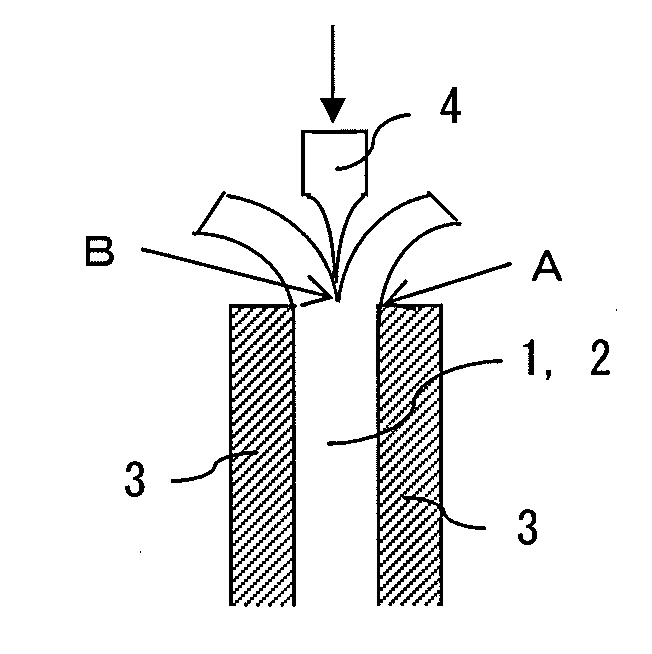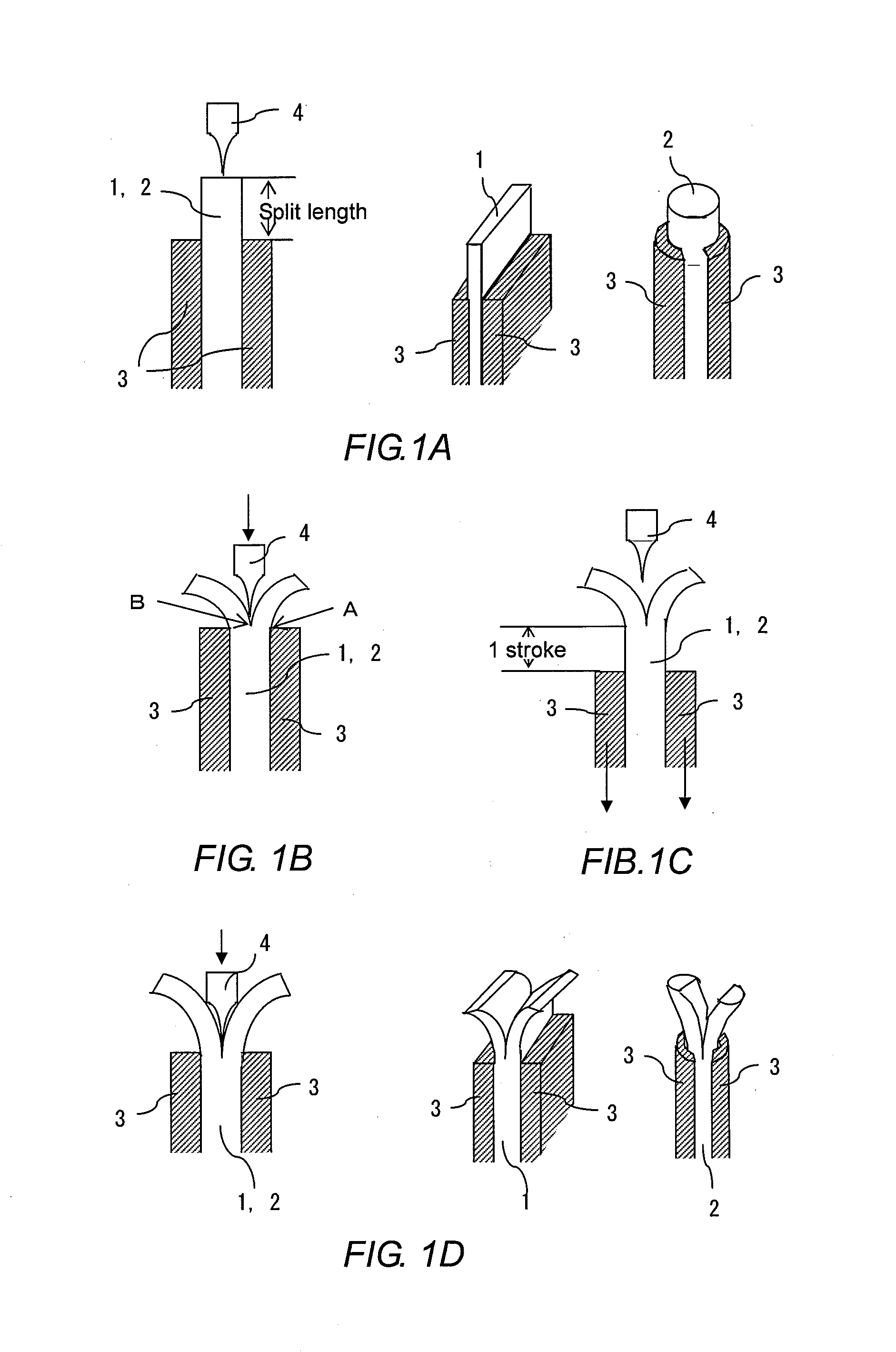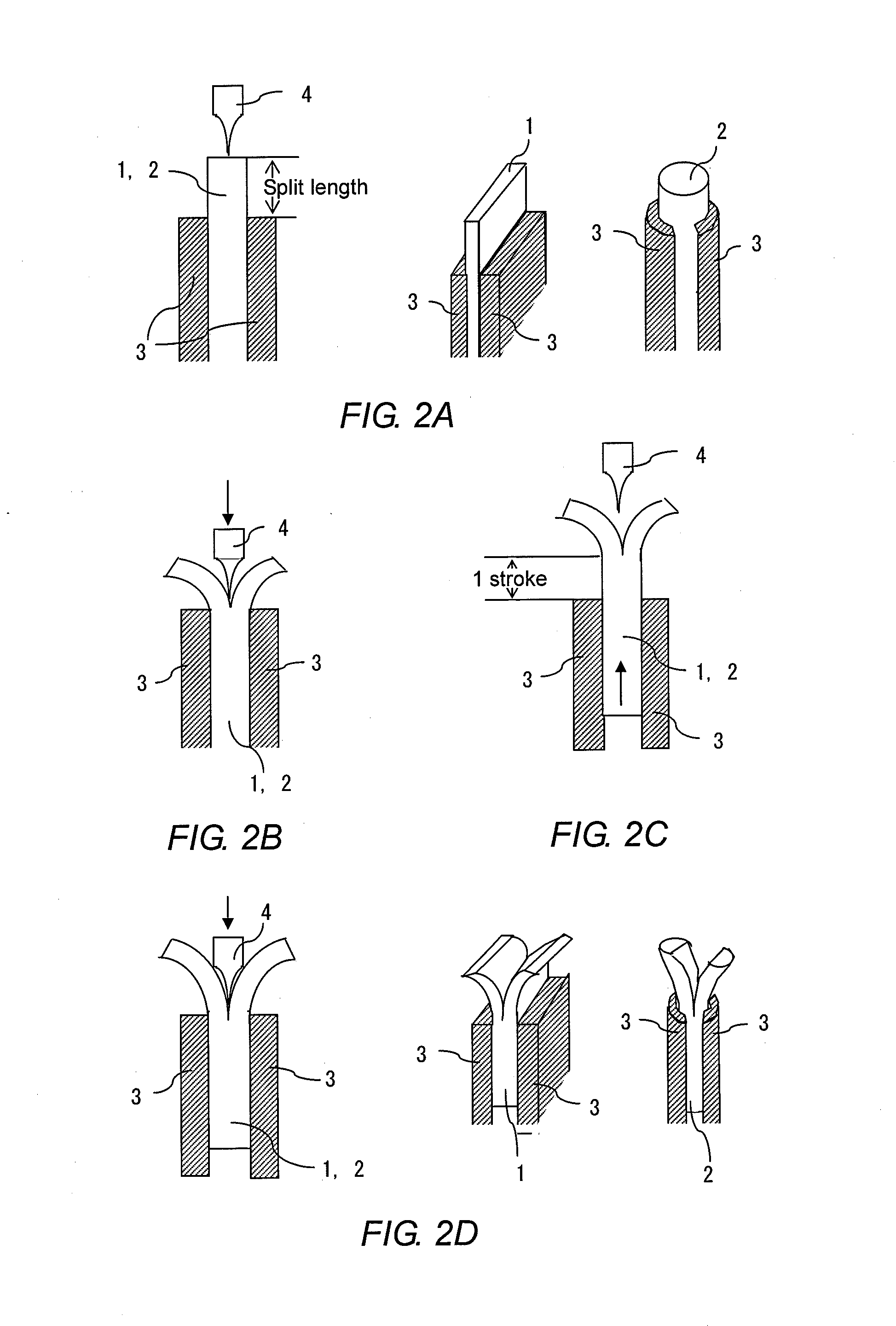Method for splitting end part of metal plate or metal rod, metal parts manufactured by such end splitting method, and method for bonding such metal parts
a technology of metal plate or metal rod and end splitter, which is applied in the direction of non-electric welding apparatus, solid-state devices, fastening means, etc., can solve the problems of low bonding strength, inability to ensure stability of the end splitter, and difficulty in obtaining a quality-adjusted bonding, etc., to achieve high end splitter accuracy, excellent productivity, and low manufacturing cost
- Summary
- Abstract
- Description
- Claims
- Application Information
AI Technical Summary
Benefits of technology
Problems solved by technology
Method used
Image
Examples
first embodiment
[0058]FIGS. 1A to 1D are an explanatory illustration of steps of the press-splitting in the first embodiment of the method for splitting the end part of a metal plate 1, or a metal rod 2, according to the present invention, wherein a slitting punch 4 is used while moving a clamping device 3. As FIGS. 1A to 1D illustrate, the end splitting method in this embodiment comprises the steps of: securing the metal plate 1 or, the metal rod 2, by pinching with the clamping device 3 (FIG. 1A); performing press-splitting applying the slitting punch 4 on the face of one end of the metal plate 1, or the metal rod 2 (FIG. 1B); moving the clamping device 3 to the split-desired position and securing again the metal plate 1, or the metal rod 2, by pinching with the clamping device 3 to secure (FIG. 1C); and applying the slitting punch 4 on the cleft of the split portion to advance splitting by the press-splitting (FIG. 1D). The steps illustrated in FIGS. 1C and 1D are repeated until the split length...
second embodiment
[0064]FIGS. 2A to 2D are an explanatory illustration of steps of the press-splitting in the second embodiment of the method for splitting the end part of a metal plate 1, or a metal rod 2, according to the present invention, wherein a slitting punch 4 is used while moving the metal plate 1, or the metal rod 2. In this embodiment, securing the metal plate 2, or the metal rod 2, by pinching with a clamping device 3 (FIG. 2A) and performing press-splitting applying the slitting punch 4 on the face of one end of the metal plate 1, or the metal rod 2 (FIG. 2B), are the same steps as those in the first embodiment illustrated in FIGS. 1A and 1B. The difference from the steps indicated in FIGS. 1A and 1B is that the metal plate 1, or the metal rod 2, is moved instead of moving the clamping device 3. The embodiment employs a step, in which the metal plate 1, or the metal rod 2, is secured again by pinching with the clamping device 3 after the metal plate 1, or the metal rod 2, is moved to th...
third embodiment
[0066]FIGS. 3A to 3D are an explanatory illustration of steps of the press-splitting in the third embodiment of the method for splitting the end part of a metal plate 1, or a metal rod 2, according to the present invention, wherein a cleaving punch 5 is used while moving a clamping device 3. As FIGS. 3A to 3D illustrate, the end splitting method in this embodiment comprises the steps of: securing the metal plate 1, or the metal rod 2, by pinching with the clamping device 3 (FIG. 3A); performing press-splitting, applying the cleaving punch 5 on the face of one end of the metal plate 1, or the metal rod 2, along one face of the clamping device 3 on one side (FIG. 3B); moving one side of the clamping device 3, which is disposed on the other side of the face on which the clamping device 3 stated above is arranged, to the split-desired position and securing again the metal plate 1, or the metal rod 2, by pinching with the clamping device 3 to secure (FIG. 3C); and applying the cleaving p...
PUM
| Property | Measurement | Unit |
|---|---|---|
| length | aaaaa | aaaaa |
| speed | aaaaa | aaaaa |
| speed | aaaaa | aaaaa |
Abstract
Description
Claims
Application Information
 Login to View More
Login to View More - R&D
- Intellectual Property
- Life Sciences
- Materials
- Tech Scout
- Unparalleled Data Quality
- Higher Quality Content
- 60% Fewer Hallucinations
Browse by: Latest US Patents, China's latest patents, Technical Efficacy Thesaurus, Application Domain, Technology Topic, Popular Technical Reports.
© 2025 PatSnap. All rights reserved.Legal|Privacy policy|Modern Slavery Act Transparency Statement|Sitemap|About US| Contact US: help@patsnap.com



